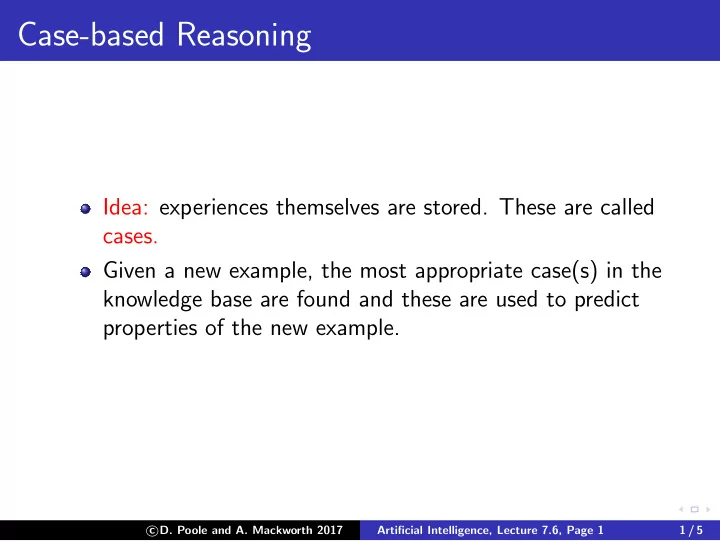

Case-based Reasoning Idea: experiences themselves are stored. These are called cases. Given a new example, the most appropriate case(s) in the knowledge base are found and these are used to predict properties of the new example. � D. Poole and A. Mackworth 2017 c Artificial Intelligence, Lecture 7.6, Page 1 1 / 5
Extremes of Case-based Reasoning The cases are simple and for each new example the agent has seen many identical instances. Use the statistics of the cases. The cases are simple but there are few exact matches. Use a distance metric to find the closest cases. The cases are complex, there are no matches. You need sophisticated reasoning to determine why an old case is like the new case. Examples: legal reasoning, case-based planning. � D. Poole and A. Mackworth 2017 c Artificial Intelligence, Lecture 7.6, Page 2 2 / 5
k -nearest Neighbors Need a distance metric between examples. Given a new example, find the k nearest neighbors of that example. Predict the classification by using the mode, median, or interpolating between the neighbors. Often want k > 1 because there can be errors in the case base. � D. Poole and A. Mackworth 2017 c Artificial Intelligence, Lecture 7.6, Page 3 3 / 5
Euclidean Distance Define a metric for each dimension (convert the values to a numerical scale). The Euclidean distance between examples x and y is: �� d ( x , y ) = w A ( x A − y A ) 2 A ◮ x A is the numerical value of attribute A for example x ◮ w A is a nonnegative real-valued parameter that specifies the relative weight of attribute A . � D. Poole and A. Mackworth 2017 c Artificial Intelligence, Lecture 7.6, Page 4 4 / 5
kd -tree Like a decision tree, but examples are stored at the leaves. The aim is to build a balanced tree; so a particular example can be found in log n time when there are n examples. Not all leaves will be an exact match for a new example. Any exact match can be found in d = log n time All examples that miss on just one attribute can be found in O ( d 2 ) time. � D. Poole and A. Mackworth 2017 c Artificial Intelligence, Lecture 7.6, Page 5 5 / 5
Recommend
More recommend